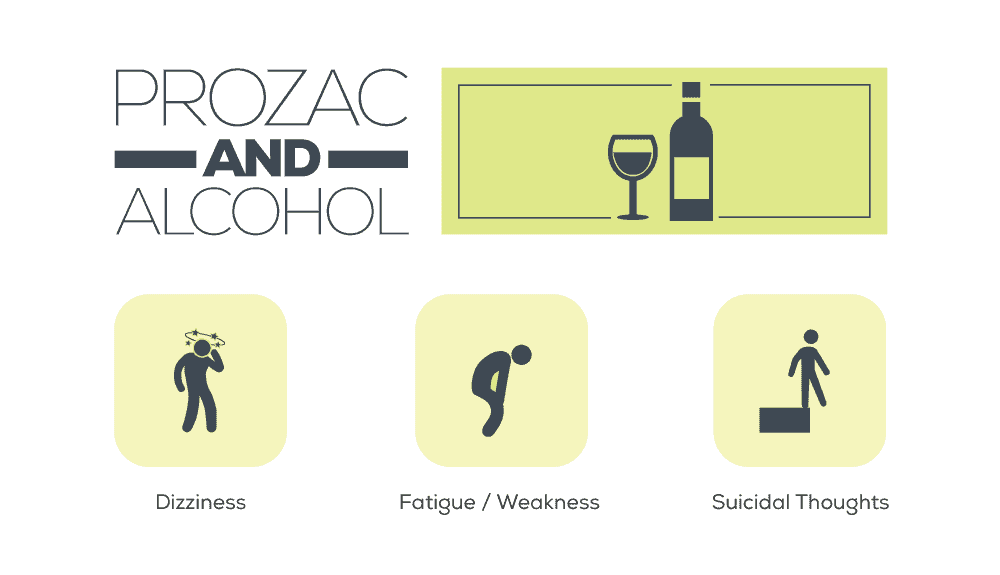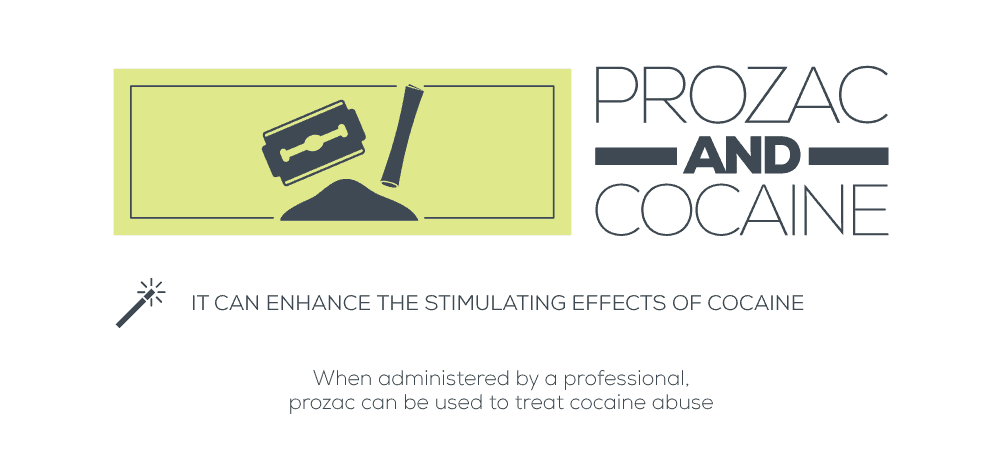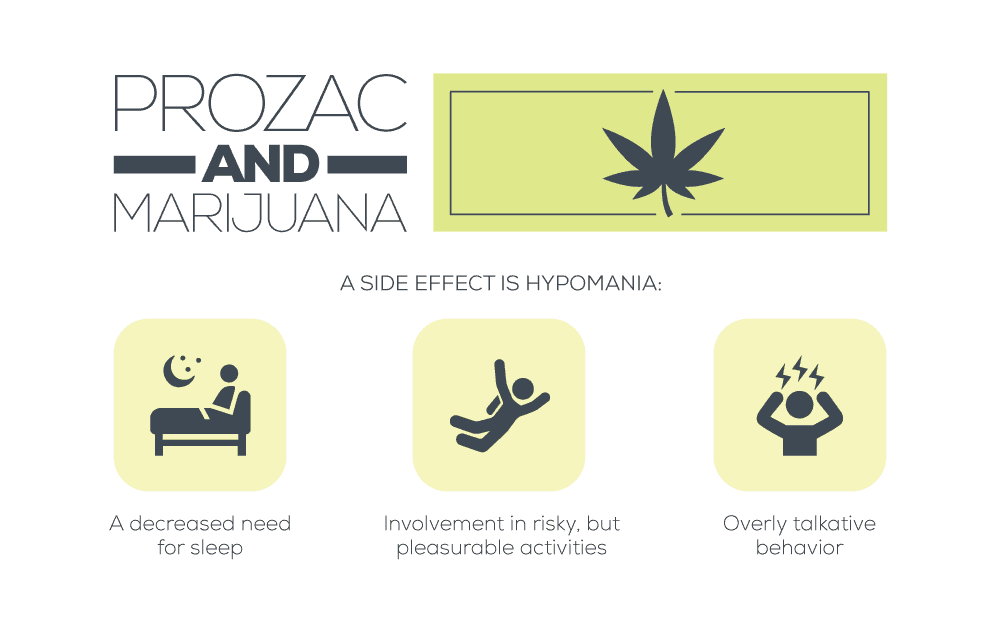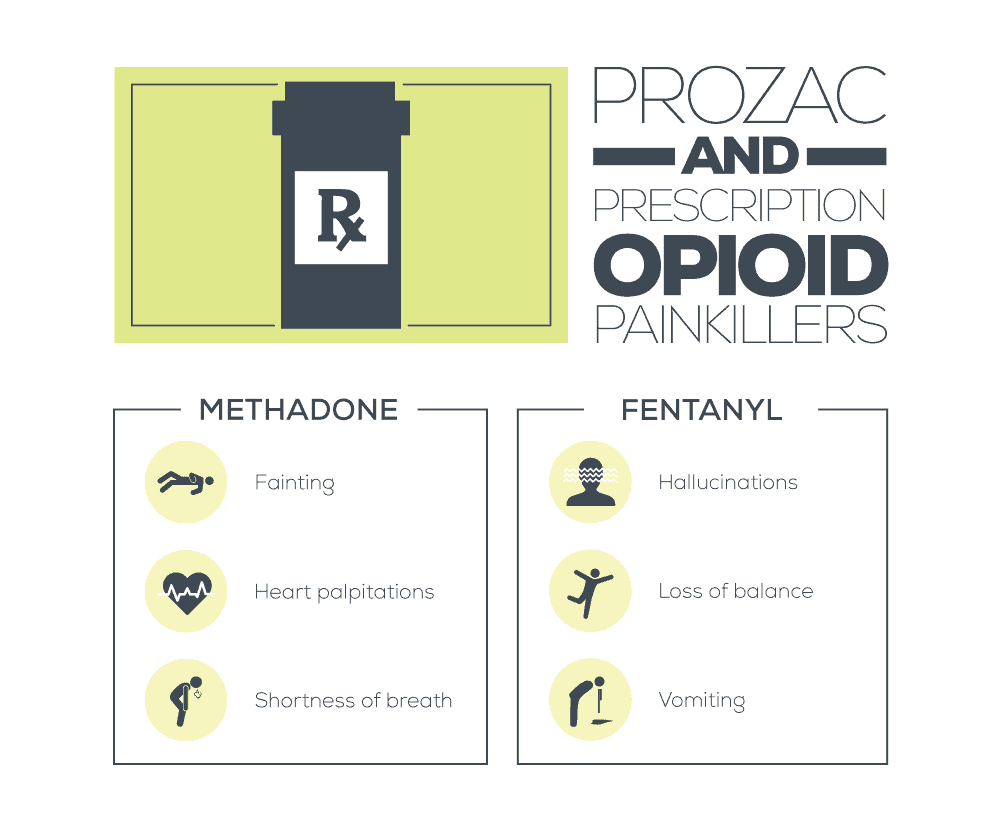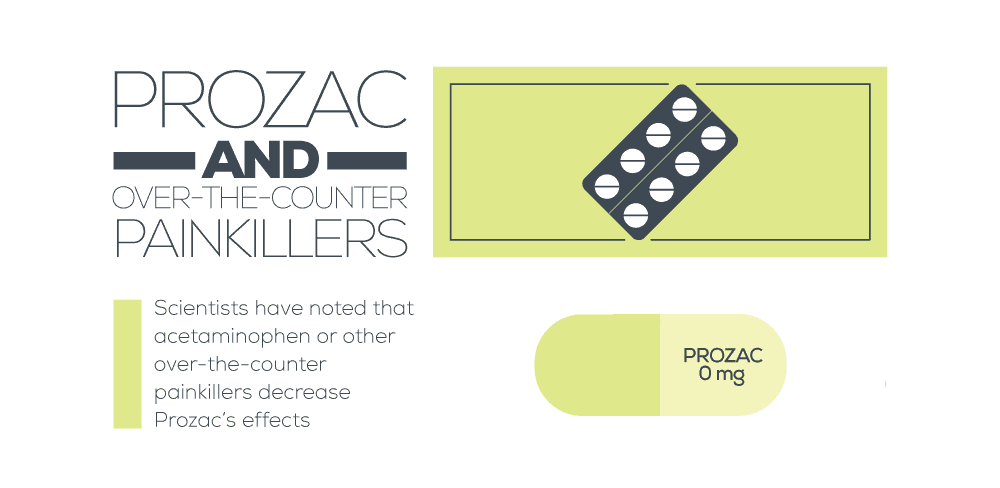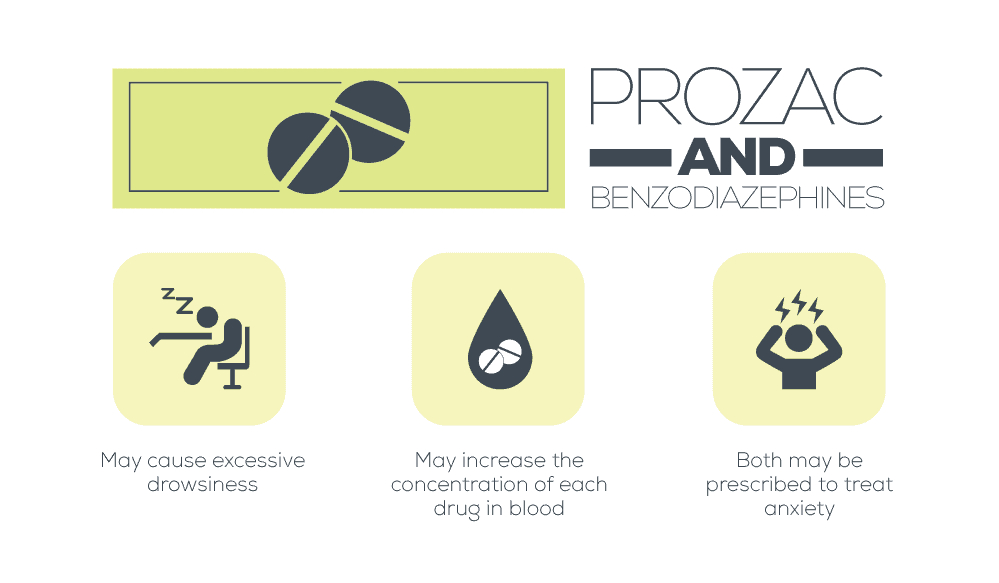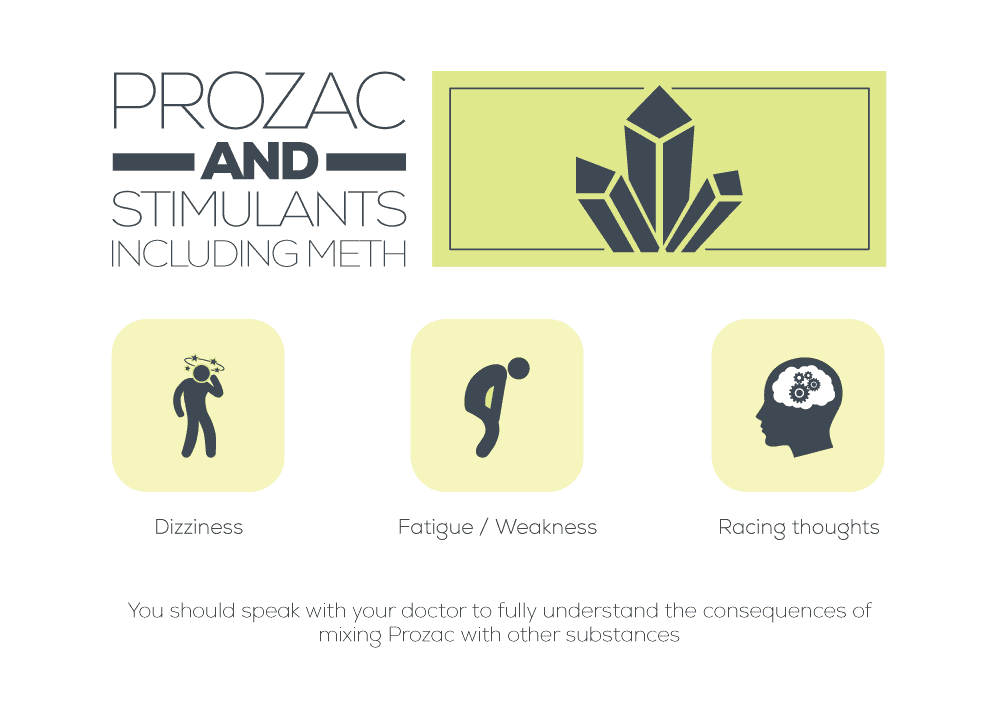Prozac is a common antidepressant prescribed to treat depression that cannot be mixed with other medications or illicit drugs. Doctors are diagnosing more and more Americans with depression. With rising depression rates, it’s no surprise that 13% of Americans take antidepressants. The depressants help stabilize and lift their moods, so they can live their life to the fullest. Prozac, otherwise known as fluoxetine, is a type of antidepressant known as selective serotonin reuptake inhibitor (SSRI). It’s used to treat not only depression, but also bulimia, obsessive-compulsive disorder (OCD), and panic disorders. This medication is quite versatile, and can treat a wide array of disorders and conditions. Most doctors prescribe a dose of 10mg to 80mg of Prozac to patients. Before this medication is prescribed, the doctors will want a detailed medical history. This is because Prozac can and will react negatively to many other medications and drugs. The adverse reactions can even turn deadly. It’s important that a patient is detoxed from all other medications and drugs before they start Prozac. Here are 8 drugs that don’t mix with Prozac. When mixed, it may cause unwanted reactions and side effects. Those who are taking Prozac should be aware of these drug interactions to avoid having to deal with unwanted side effects.
“Get your loved one the help they need. Our rehab program accepts many health insurance plans, this is our residential program.”
#1 Prozac and Alcohol
Drinking is a big no-no when taking Prozac. Alcohol is a depressant that will slow down and even inhibit certain messages and signals in your brain. Like alcohol, Prozac can have similar effects. For one, it can cause tiredness and can interfere with one’s balance and motor function. Those who choose to combine Prozac and alcohol together will experience an increased sedative effect. This effect can be quite dangerous. For example, it increases the risk of falls and injuries, and it promotes poor decision-making abilities. Essentially, these two drugs amplify and magnify each other’s effects when mixed together. Prozac is often not prescribed to patients with an alcohol addiction or who frequently consume alcohol. Most doctors will want to discuss the dangers of mixing the two at length, so patients know not to do it. Combining both Prozac and alcohol can also lead to many unwanted side effects, like:
- Dizziness
- Extreme fatigue and weakness
- Feeling of hopelessness
- Suicidal thoughts
Alcohol can prevent Prozac from working properly in the body. This means that patients won’t be getting the full effect. Prozac won’t stop the sedative effects of alcohol, and alcohol won’t allow Prozac to have an optimal effect in treating depression.
When Can You Drink Alcohol Again?
Unlike with many other medications, a patient cannot simply wait a few hours after taking Prozac to drink. This is because Prozac has a fairly long half-life in the body, and will remain as a metabolite for quite some time. The half-life of fluoxetine ranges from 2 to 7 days. This means that it can take anywhere from 11 to 38.5 days for the body to clear Prozac completely. This means that patients can’t and shouldn’t drink alcohol for at least up to a month and a half after they’ve last taken Prozac. Even if the active ingredient of fluoxetine is successfully removed from the body, it doesn’t mean that its metabolites are cleared as well. Just like fluoxetine, the metabolites can react with alcohol as well. The primary metabolite of fluoxetine is known as norfluoxetine. This compound has double the half-life of fluoxetine and has a half-life of anywhere from 4 to 15 days. It can take months for the body to get rid of this compound. If a patient is trying to control or manage his or her drinking, there’s some good news to all of this. Some researches have shown that Prozac may be capable of curbing physical cravings. After detoxing from alcohol, Prozac may help treat an alcohol addiction.
#2 Prozac and Cocaine
Just like with alcohol, research has shown that Prozac reacts with illicit drugs as well. Since Prozac is a serotonin reuptake inhibitor, it can enhance the stimulating effects of cocaine use. Drug users may feel a more potent high, or may feel more energetic when combining both drugs together. Unfortunately, the mechanism of action between how Prozac interferes with cocaine is still not known. The best theory is that Prozac interferes with enzymes that metabolize cocaine. Those who take Prozac with cocaine will have higher concentrations of cocaine in the body at the end of the day. This is because the body is unable to process and metabolize the drug efficiently. Both drugs should not be mixed together, as it opens up the potential for an increased risk of overdoses. The two drugs may overwhelm the body. Also, since the body is unable to metabolize the cocaine, large doses used cocaine addicts may easily cause overdoses and other unwanted side effects.
Current Research Involving Concurrent Prozac and Cocaine Use
Surprisingly, when administered by a professional, Prozac may have the potential and ability to treat cocaine abuse. Studies have shown that Prozac can attenuate the mydriatic effects of cocaine. It can decrease positive mood effects without causing any major physiologic interactions in the body. It’s important to note that patients should not try to self-medicate themselves. There’s a fine line between treatment and a dangerous dose. Those who attempt to self-medicate may put themselves in a dangerous situation. After all, patients are under careful supervision if prescribed by a doctor.
#3 Prozac and Marijuana
One of the top 15 most used drugs in America is marijuana. Patients who are taking Prozac to treat depression are also likely to self-medicate with marijuana. After all, both drugs are designed to help lift a person’s mood, and leave them in better spirits. Unfortunately, combining the two may not necessarily be safe. There is only a moderate risk involved with mixing marijuana and Prozac. The side effects to look out for include increased sedative effects and hypomania. Hypomania is a mild form of mania. It is often characterized by periods of hyperactivity and elation. This can have a lasting effect on one’s psychological health. We’ll explore this symptom below. Another key feature to point out is that research shows that those who take Prozac and marijuana together are less likely to stay complacent with their treatment plan. They are more likely to miss a dose or stop taking their medications completely.
Symptoms of Hypomania
Since hypomania is the main side effect of Prozac and cannabis use, it’s a good idea to familiarize with the symptoms of this condition. Hypomania is classified as the presence of 3 of the following symptoms:
- An inflated self-esteem, self-confident or grandiosity
- A decreased need for sleep
- An excessive involvement in risky, but pleasurable activities
- Increased distractibility and an inability to stay focused
- Overly talkative behavior
- Need to participate in goal-directed activities
- Racing thoughts or subjective experiences
Fortunately, hypomanic episodes do not necessitate hospitalization. This is mainly because it does not involve any psychotic effects and features, like hallucinations. With that said, hypomania can completely change a person’s behavior. For example, he or she may become a lot more sociable or outgoing.
#4 Prozac and Prescription Opioid Painkillers
Opioid use in America has gotten out of hand; overdose rates are skyrocketing to unfathomable heights. With that said, Prozac and opioids don’t mix well together. However, the effects of mixing the two drugs will vary depending on the type of opioid that is used. Some opioids won’t elicit a reaction even when combined with Prozac. To avoid any adverse reactions, it’s best to avoid mixing the two different types altogether. It’s not worth the risk. Since the side effects will vary depending on the type of drug, let’s take a look at some examples. Some of the most commonly taken opioids include methadone, fentanyl and naloxone.
Methadone
Methadone is often used in Opiate Replacement Therapy (ORT). It plays a crucial role in opioid detox. Concurrent use of Prozac and methadone can result in an increased risk of arrhythmia. While this side effect is a bit rare, it can be life threatening. Side effects are more prevalent among patients struggling with a heart condition. Depending on each patient’s situation, some doctors may prescribe Prozac and methadone together. These patients will need around-the-clock supervision, as their condition is much more critical. Some other common side effects of taking Prozac and methadone together include:
- Fainting
- Heart palpitations
- Lightheadedness
- Shortness of breath
- Sudden dizziness
Those who experience consistent and persistent side effects should speak to their doctor. The same can be said for those who feel that the side effects are worsening. In these situations, the doctor may recommend switching to another drug combination, or may decide to stop prescribing one of the drugs completely.
Fentanyl
Those who mix fentanyl with Prozac are more likely to develop serotonin syndrome. This happens when large levels of serotonin can accumulate within the body. They overwhelm the entire system. The side effects of this condition include:
- Blurred vision
- Changes in blood pressure
- Confusion
- Fever
- Hallucinations
- Increased heart rate
- Loss of balance and coordination
- Muscle spasm and/or stiffness
- Nausea
- Profuse sweating
- Shaking or shivering
- Seizures and tremors
- Vomiting and diarrhea
In worst-case scenarios, serotonin syndrome can result in coma or death. It’s vital that a doctor is aware of when the two drugs are being mixed together. It’s also important to note that a serotonin syndrome can be treated by discontinuing all medications. Patients who are extremely agitated may take benzodiazepines to help ease any side effects they experience.
Other Opioids Containing Codeine, Hydrocodone or Naloxone
Some prescription drugs aren’t necessarily classified as opioids; however, they do contain opioids in them. Common ingredients include codeine, hydrocodone or naloxone. These drugs may also have a negative reaction in the body when mixed with Prozac. They may result in the development of serotonin syndrome, as well as many other side effects.
#5 Prozac and Over-the-Counter Painkillers
In addition to the adverse effects that can be expected with prescription opioids, over-the-counter painkillers may also react negatively with Prozac. Both drugs may target the same protein receptors in the brain. Over-the-counter painkillers can block the effectiveness of antidepressants, like Prozac. However, the exact mechanism of action is unknown. Most scientists theorize that painkiller pills may disrupt selective serotonin reuptake inhibitors (SSRIs). The reaction between the two drugs is not just a theory. It’s been tested time and time again. Scientists have noticed that patients who take acetaminophen or other over-the-counter painkillers are less likely to experience relief from Prozac. They will still struggle with depression. In fact, their progress may be equivalent to a person who is not being medicated with Prozac. While the results are known, no one knows exactly just how large of a dose of painkiller will interfere with Prozac. Some patients may find that even a small dose of painkillers can render Prozac useless. If a patient is not responding to Prozac, the doctor will want to figure out there was a concurrent use of pain pills.
“We treat both addiction and co-occurring disorders and accept many health insurance plans. Take a look at our inpatient program.”
#6 Prozac and Benzodiazepines
Benzodiazepines are also common medication used in America. Both are often used to treat anxiety. While they may both be effective, combining the two may not always yield positive results. Different benzodiazepines can cause various unwanted side effects. For example, Xanax is often used to treat anxiety. When paired with Prozac, the two drugs will play off of one another and cause excessive drowsiness. This may prevent some patients from being able to run daily errands. Both drugs may also increase the concentration of each drug in the bloodstream. It may also cause the drugs to stay for a longer amount of time in the body. While patients shouldn’t decide to mix the two drugs together at a whim, some doctors may choose to combine the two when treating anxiety. It’s important to note that the mixing of both drugs is only safe when done under medical supervision. Some studies have shown that combination therapy may be more effective than just taking one drug at a time. It’s particularly effective among patients with comorbid anxiety and depression.
#7 Prozac and Stimulants Used to Treat ADHD
Among all the drugs that don’t mix well with Prozac, stimulants prescribed for ADHD is one of the biggest ones to remember. Amphetamines, like Adderall, interfere with the chemical pathway of Prozac and vice versa. Most importantly, however, is that Prozac will significantly block the metabolic pathway of amphetamines. This means that it becomes a lot easier for patients to overdose on amphetamines. Many patients take Adderall to deal with their inability to focus, and may accidentally mix the two drugs together if they also struggle with anxiety or depression. When Prozac is mixed with Adderall, patients can also expect certain side effects like:
- Anxiety
- Jitteriness
- Nervousness
- Restlessness
- Racing thoughts
Combining these two drugs can also increase one’s risk of developing serotonin syndrome. This syndrome comes with some nasty side effects, and can even result in coma or death. This syndrome is a common side effect of mixing Prozac with any other type of drug. Mixing the two drugs can also cause patients to become angry and irrational. They may be unable to sleep and eat, and may also become destructive. Their entire personality and behavior may change drastically. In most cases, close family members and friends should notice the behavioral changes almost immediately.
#8 Prozac and Methamphetamines
Methamphetamine use has been climbing at alarming rates. In 2013, more than 500,000 million people admitted to using and abusing this drug. Unfortunately, the numbers have only continued to rise over the years. Much like with many other drugs, it’s not wise to mix Prozac and methamphetamines together. The two react negatively off of one another and can cause an array of unwanted side effects. In particular, it can also result in the development of serotonin syndrome, which can be quite deadly. It’s definitely not worth mixing the two. Those who do may have a difficult time recovering, and may also sustain permanent bodily damages to the brain and to the nerves. The extent of the damage will depend on the dose taken, one’s biological makeup, among many other factors.
“We accept many health insurance plans. Get your life back in order, take a look at our residential program.”
Use Prozac As Prescribed
Simply put, Prozac is not a drug that should be mixed with any other medications or substances. It reacts poorly with almost every other chemical compound. In fact, Drugs.com lists 1833 brand and generic drug names that are known to have major interactions with Prozac. If you are prescribed Prozac by a doctor, make sure that you take the medication as prescribed. Don’t mix multiple substances together. If you do, it may result in some dire consequences. You should also speak with your doctor to fully understand the consequences of mixing certain substances together with Prozac. With that said, if you’re addicted to other drugs or Prozac, it’s time to take action now. Contact us for more information on the various types of polydrug use addiction programs we offer. We’d be more than happy to walk you through each step, so you know what to expect on your road to recovery.
What Did you Think About This Blog?
Give it a Rating!


